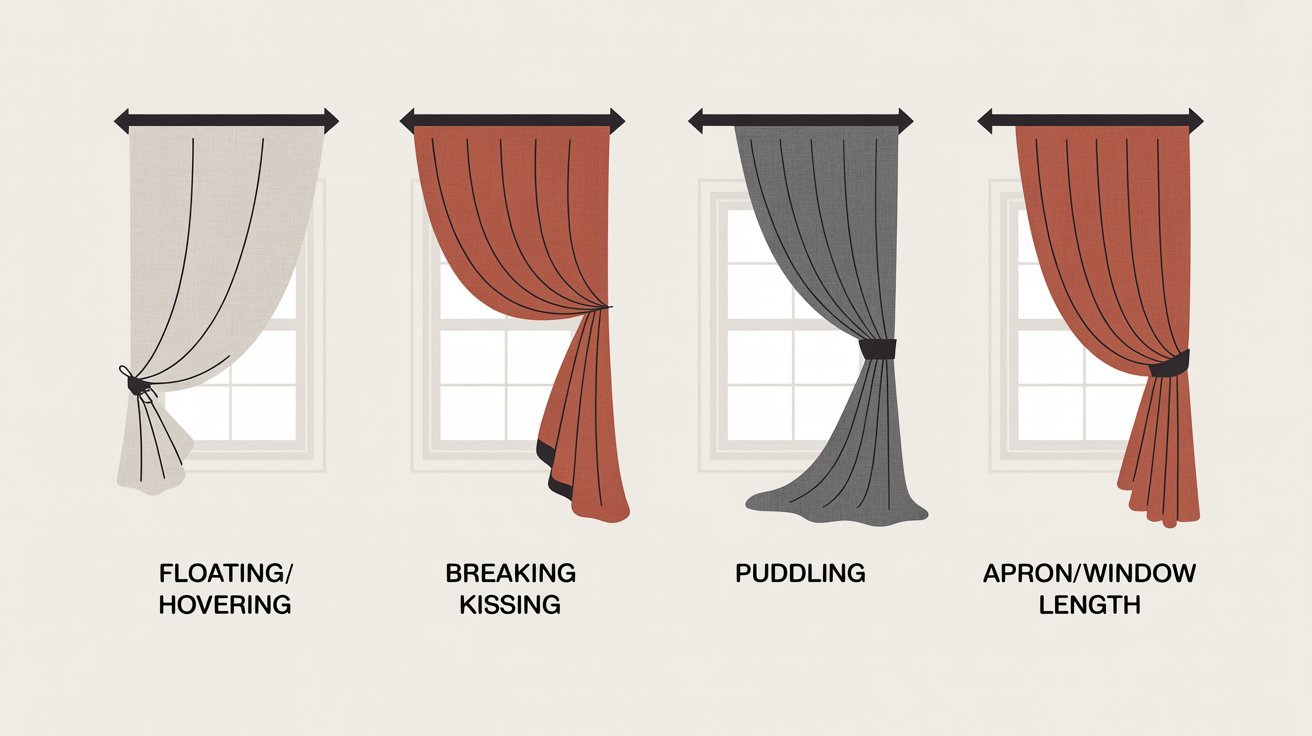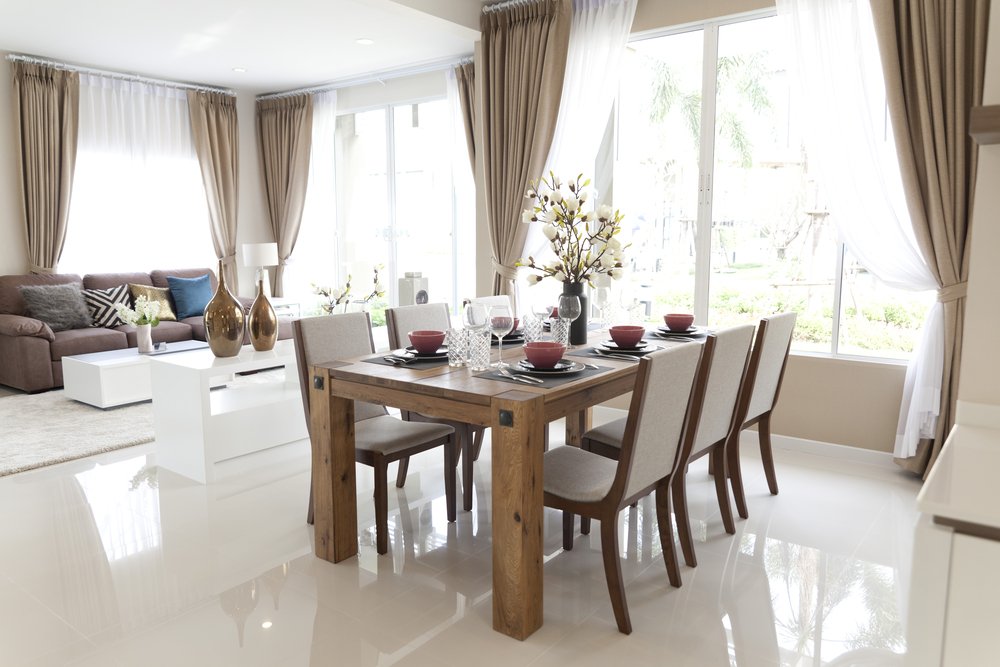Key Takeaways
- Drape length impacts both style and function—too short looks awkward, too long can be messy or unsafe.
- Floor-touching drapes offer elegance and better insulation, but require more cleaning and care.
- Choose the right style for the space—floating for busy areas, kissing for elegance, puddling for formal rooms, and shorter drapes for kitchens/baths.
- Proper measuring and high rod placement help drapes look polished and make rooms feel taller and more spacious.
Drapes are long pieces of heavy fabric that hang over windows to make rooms look beautiful, block out light, help save energy, and give you privacy when you need it. When setting up your home, you might wonder if drapes should touch the floor or not. People care about this because the length of your drapes can change how your entire room looks and feels. It’s not only about style—it’s also about cleaning, safety, and how easy it is to use your drapes every day.
Why Does Drape Length Matter?
The way you hang your drapes changes the look of your room right away. If your drapes are too short, your room might seem unfinished, kind of like wearing pants that are way too high above your ankles. But if they’re too long and pile up on the floor, they can look messy or out of place and might even get in the way. On the other hand, drapes that are the right length make your room feel bigger, cozier, and more stylish. They can even help control light, add privacy, and keep your space warmer or cooler.
Pros of Drapes Touching the Floor
Makes a Room Look Elegant
When drapes touch the floor, your room instantly looks more put-together and grand. This style adds height to your walls and makes your ceilings feel higher, making even small rooms look impressive.
Hides Outlets and Cords
Long drapes cover up things like power outlets or messy cords near the bottom of your floor, keeping your room looking neat.
Better Insulation & Light Blocking
Drapes that touch the floor make it harder for cold air to sneak in during winter and keep cool air inside during summer, saving you money on energy bills. When closed, they also block out more sunlight, making bedrooms and living rooms very cozy and private.
Cons of Drapes Touching the Floor
Collecting Dust and Pet Hair
Drapes that touch the floor can easily pick up dust, dirt, and pet fur because they are right on top of the ground. They need to be cleaned much more often than shorter ones.
A Tripping Hazard
Extra fabric on the floor isn’t safe in homes with kids, pets, or older adults, as someone could trip and fall if not careful.
Difficult to Use and Maintain
If drapes are too long, they might be hard to open and close, especially if they drag on the floor or get caught on something. They can also wrinkle more easily or get worn out faster from rubbing against the ground.
Types of Drape Styles and Where They End

| Style Name | Where They End | Look | Best For |
| Floating/Hovering | ½–1 inch above the floor | Modern, tidy | Busy rooms and easy cleaning |
| Breaking/Kissing | Just touches the floor | Tailored, elegant | Bedrooms, living rooms |
| Puddling | 2–6+ inches on the floor | Dramatic, fancy | Formal, low-traffic spaces |
| Apron/Window Length | Below sill, above floor | Practical, simple | Kitchens, baths, window seats |
Detailed Descriptions
Floating/Hovering
These drapes stop just above the floor not touching it. This look is great for high-traffic rooms and for people who have pets or kids and want easy cleaning.
Breaking/Kissing
This style means the fabric barely touches the floor like a gentle touch. It looks professional and fits most formal rooms.
Puddling
If you want a dramatic, luxury vibe, puddling is the way to go here, the fabric pools onto the floor, sometimes by several inches. While it’s elegant, it can collect even more dust and be a tripping risk, so it’s best in rooms where you don’t walk around a lot.
Apron/Window Length
These are short drapes that hang below the window sill but above the floor. They’re best for kitchens, bathrooms, or windows with radiators or furniture underneath.

How Do You Choose the Best Drape Length?
Room Type:
For living rooms and bedrooms, pick drapes that just touch the floor or float slightly above it for a stylish, inviting look. Kitchens and bathrooms need shorter drapes for safer, easier cleaning.
Drape Fabric:
Thick, heavy fabrics (like velvet) look good puddled or just kissing the floor. Lighter fabrics (like linen) hang well if they float or barely touch the floor.
Floor & Room Size:
For high ceilings, longer drapes add balance, making rooms feel taller. In small rooms, consider floating drapes for a neat, open feel.
Pets or Kids:
If you have pets and kids, avoid puddles or breaking styles to reduce cleaning and accidents. Floating drapes are safest and easiest to maintain.
Your Personal Taste:
Choose what you like! Want modern, easy cleaning? Pick floating drapes. Prefer drama? Try a puddle, but only if you’re okay with extra cleaning.
How Do You Measure and Hang Drapes Correctly?
Picking the Style:
Decide which finish you want floating, kissing, or puddling. Remember, each style needs slightly different measurements.
Measuring Height:
Measure from where you’ll hang the rod to the floor. Subtract about half an inch for floating. Add or subtract as needed for kissing or puddling.
Making Windows Look Taller:
Hang the rod 4 to 6 inches above the window or as close to the ceiling as you can. This makes your window and room feel taller.
Measuring for Width:
To make sure drapes cover the window and look full, use drape panels that are 2 to 3 times wider than your window.
Handling Uneven Floors:
If your floor isn’t flat, adjust the length of each panel slightly or pick a breaking or puddled style—the extra fabric can hide small differences.
Mounting the Rod:
Attach the rod to wall studs if you can, or use wall anchors for heavy drapes. Brackets should extend past the window trim, so curtains hang properly.

Common Drape Mistakes (and How to Fix Them)
Curtains Too Short:
Don’t let curtains hover too far above the floor; it makes a room look odd and unfinished. Fix by re-hanging the rod higher or getting longer drapes.
Hanging the Rod Too Low:
Rod should be much higher than the window frame—near the ceiling is best—for that dramatic, pro look.
Drapes Too Narrow:
If your curtains are thin or flat, your windows look smaller and lifeless. Always go for fuller panels.
Ignoring the Room’s Needs:
Floor-length drapes in kitchens or bathrooms are likely to get dirty and can be unsafe. Know your space.
Choosing the Wrong Fabric:
Heavy fabrics in small rooms can feel overwhelming; lightweight in a formal space may look too casual.
Final Advice: How to Make the Right Choice
Picking the right drape length is about balancing the look you love with what your room needs. If you want an elegant and finished style, drapes that just touch the floor or hover above it are the best option for most spaces. Floating is safe for busy homes, breaking is ideal for a formal look, and puddling is for special rooms where beauty matters more than cleanup. Always measure carefully and think about your daily life, cleaning routine, and who lives in your home. Your house is personal—go with a style you enjoy and feel comfortable maintaining. By understanding these details, you’ll enjoy lovely, functional drapes that make your space more beautiful and practical every single day.

